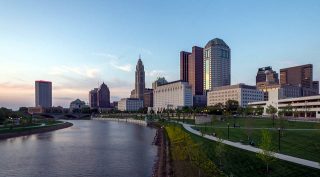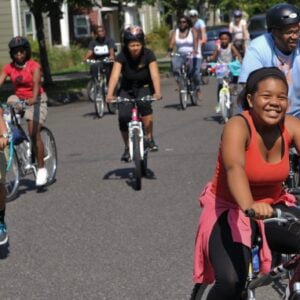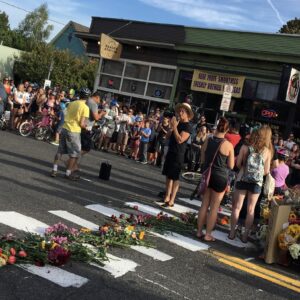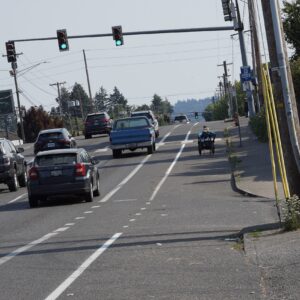
(Photo: Sean Denney)
Well, it’s a nice week to be an Ohioan.
Two days after the NBA Championship, the Buckeye State’s capital has apparently scored a $40 million federal grant that’ll be matched by $100 million in private investment to create a model of a future tech-connected city.
Columbus beat out Portland, San Francisco, Austin, Denver, Pittsburgh and Kansas City for the Smart City Challenge victory, an initiative of U.S. Transportation Secretary Anthony Foxx.
The news was first reported by Columbus Business First, which told the Pittsburgh Business Times that it had gotten the information from Ohio Sen. Sherrod Brown. Columbus CEO magazine offered further confirming details.
Though many of the elements of Columbus’s proposal are similar to Portland’s ultimately unsuccessful one — a multimodal mobility app, electric vehicle charging stations — two things jump out as being absent from Portland’s proposal:
• Local Columbus companies pledged $90 million of their own investment in smart transportation technology as part of the matching-fund total.
It’s hard to say how much of this is just clever repackaging of money that would have been spent anyway, but it’s a very impressive sum. Portland’s application drew lots of letters of support but no local financial commitments like that.
• A self-driving fixed-route transit line through the job-rich Easton neighborhood is one of the marquee elements of the Columbus plan — one of the few that the Washington Post mentioned specifically in its June 9 overview.
Though Portland’s initial proposal for the challenge included self-driving transit over Tilikum Crossing, this was scrapped from Portland’s final application. Adrian Pearmine of DKS Associates, who helped prepare Portland’s application, told me May 16 that TriMet had vetoed this element.
In January, we reported one Portlander’s interesting warning that unless U.S. cities develop self-driving transit lines (which would be far cheaper to operate and therefore potentially much more frequent) riding in cars could get catastrophically appealing compared to the alternatives.
Advertisement
There were surely many reasons Columbus won this contest, some beyond Portland’s immediate control. From the Post:
With its mix of blue-collar, white-collar and older workers, and its diversity, firms such as McDonald’s and brands such as Victoria’s Secret have seen Columbus as the “test marketing capital of the world,” the city’s mayor says. Now they want to test-market tricked-out road networks.
If new ideas come from Columbus, the ones that work might be easier to export.
This may come off as faint praise (if it helps, I grew up in Toledo) but few American metro areas of 1 million residents have more generic reputations than Columbus. If Portland had won this challenge and led the nation in next-generation traffic signal and mobility technology, it might have been easy for people in Tallahassee to inaccurately dismiss the best ideas as things that only work for bourgeois hippies. If new ideas come from Columbus, the ones that work might be easier to export.
But of course, Portland didn’t always have a national reputation as an innovator. It earned the one it has, starting with its urban growth boundary in the 1970s and continuing with light rail, parking reform, modern streetcars and bicycle transportation.
Investments like this one are exactly the way cities build reputations, and become the Portlands — or at least the slightly more awesome Columbuses — of the future.
— Michael Andersen, (503) 333-7824 – michael@bikeportland.org
Our work is supported by subscribers. Please become one today.
Correction 6/22: An earlier version of this post confused the Columbus neighborhoods of Easton and Linden.







Thanks for reading.
BikePortland has served this community with independent community journalism since 2005. We rely on subscriptions from readers like you to survive. Your financial support is vital in keeping this valuable resource alive and well.
Please subscribe today to strengthen and expand our work.
“Adrian Pearmine of DKS Associates, who helped prepare Portland’s application, told me May 16 that TriMet had vetoed this element.”
Why is there no citizen oversight of this backward and regressive organization?
It’s going to be very hard for TriMet to navigate this new world of self-driving vehicles when they have a union that will fight it tooth and nail. I fear that our transit system will crumble by failing to adapt, just like the streetcar systems back in the 30s and 40s (which was self-inflicted and not the target of an automaker conspiracy, contrary to popular myth).
There is citizen oversight in the form of the public attending board meetings and complaining to a group of volunteers that have no interest or requirement to use transit. One board member infrequently uses transit; the rest do not.
The main issue (among many) with TriMet is that they have a huge lag in competency:
-understanding what [young-er] people want/value (time),
-understanding how to adjust their schedules/products to the dynamics of urban/suburban lifestyles (BRT, commuter bus service, dial-a-ride service, owl service, all door boarding, etc.), and
-how to manage the existing service.
[Young-er] People that are moving here from other cities opens up a huge market for potential customers, yet the agency believes that active engagement with them is not required. The logic follows that if the blue pole is in the ground people will figure it out. However, without some type of engagement, people will do other things to manage their time (bike, drive, walk). People want to be in control of their time and do not wanted to be delayed/stranded/held hostage by their transit agency which is supposed to, borrowing from Jarrett Walker, provide the public with the freedom to do the things they enjoy the most. There was once a study that argued that a simple way to increase ridership is to have schedules posted at stops. TriMet saw this as an expense (labor and maintenance) so they removed the schedules from the poles and force people to call/text/internet/use an app to find out when the next bus is coming. This completely alienates large segments of the population who are on the fringes of technology use.
The agency also needs to embrace new ways of getting people to destinations. It is astounding that an agency this size does not have vehicles larger than 40′. They do have excuses (streets are too tight, too many bikes, too many cars, too many turns, not enough mechanics, tried it in the 80s, etc.) This again speaks to competency: properly trained operators can navigate all of these issues safely. Metro in Seattle, has similar operating conditions and significantly more turns yet they run 60′ vehicles all day/night with few reported issues.
The last bullet will be summarized as such: If you, as a customer:
-see three buses in quick succession,
-all for the same route
-headed in the same direction, and
-you observe that there are fewer and fewer people on the following buses, then the service is not being managed.
While the union is a strong influencer on issues pertaining to labor, the leadership that exists is not interested in providing service to the customer but maintaining the status quo of service: “you got a train/bus, what is your issue?”
I would like to make a clarification here. While we did remove the Tillicum Crossing component from the Final proposal due to operational issues on the bridge, the City of Portland still had a significant part of the proposal that involved neighborhood shuttles, including autonomous neighborhood shuttles, augmenting transit service. I do not think that the Tillicum Crossing issue had a single thing to do about USDOT selecting Columbus over Portland for the Smart Cities Challenge. TriMet was a wonderful partner to City of Portland throughout the process of responding to the challenge and brought innovative technical and operational ideas to the table.
Urban growth boundaries are a State of Oregon invention, not Portland.
That’s true, but Portlanders were certainly part of the coalition that made it happen, and the Portland metro area is the one that’s been affected by far the most.
What percentage of the population in eastern Oregon was in favor of the UGB bill?
The first ballot measure to overturn it (Measure 12 in 1975) was defeated 61%–38%. SB 100 had broad support among farmers and ranchers who were worried about urban sprawl.
…actually islands like Honolulu…are the first true urban growth boundary.
Honolulu is not an island.
No, but it’s a county and a metro which includes all of Oahu.
Honolulu County is indeed an island. The entire island of Oahu is Honolulu County. I guess we can all be anal about these things.
I thought Portland made a good gamble putting bikes front and center, which differentiated it from the other proposals and aligned it with how the secretary’s been talking lately. It didn’t pay off, but it was a good proposal.
Now Portland can covet two things Columbus has: smart city money and an NHL team.
the slightly more awesome Columbuses
Wouldn’t that be Columbi? 😉
Congratulations to Columbus and Ohio. And thanks for this insightful article. The possible reasons Portland didn’t succeed, and the potential benefits to the rest of the country, are both worth considering.
I can’t help thinking, too, that one of these days these “slaps to the face” of Portland’s self-importance might get things moving here again.
Losing once in a while can be healthy.
This city has been full of itself for way too long.
yet Portland and Oregon are moving away from cars. What auto factories are in Oregon? The last major auto race in Oregon was in 2007 with Champ Car at PIR. Bizarre choice for Ohio.
…though Portland Parks has PIR up and running most summer weekends…from the smell and sound of it.
I was at that Champ Race in 2007 and it was really fun to watch. I love riding my bike to PIR.
they probably need it more than us… driving to/from the airport and walking around the suburb of Reynoldsburg it’s clear that cars are the only form of transport they really care about… barely any bike lanes in the area…
Portland’s pitch was weak. Plenty of apps that will tell you travel times based on mode already exist. To me, it just seemed like a clever way to pretend to care about improving transit without actually building anything. Even after watching the video, my takeaway was that BRT or rail transport would serve the people in the video better than any app that would – lets be honest here – just tell them to drive anyway because the bus is too slow.
The proposal was about far more than an app, though this one element was highlighted in the video. I’d invite you to look at the full proposal here which is a lot more multifacted than just that one piece. Hopefully Portland can find a way to move some of these ideas forward without the grant.
https://www.portlandoregon.gov/transportation/article/579820
“A self-driving fixed-route transit line through the job-poor Easton neighborhood…”
That’s not quite accurate. Easton is a giant mall with lots of jobs and money, on the extreme eastern edge of Columbus. Ironically, because its so far out, there’s poor public transit to the area, a fact that hurts the working poor on the near east side of town. It’s a mall Robert Moses would be proud of: with a dedicated exit on the outer-belt, and most easily accessible by car.
What the Columbus proposal really says is that they’d like to help the denizens of the near-east side neighborhoods, collectively known as “Linden”, through improved public transit:
“Run an autonomous circulator in one of Ohio’s largest job centers, Easton, which is adjacent to Linden and which proponents say would make access easier for people in both communities.”
…so is this line of reasoning meaning that Portland would have had a stronger proposal application if it chose Columbus’ pitch and the regional solution included the commuters between Vancouver / Portland and Portland / Vancouver?
Conservatives insistence that MAX can’t be allowed to cross the Columbia River to Vancover as part of any new Interstate Bridge project because of a vote that took place there years ago probably didn’t help Portland’s case. The fact that we don’t have a bike route system serving all quadrants of the area didn’t help. The car centric plan put out by Columbus seems to be so out of touch with the times! One gets the sense that one of the takeaways from this is that Portland must build I-205 as a 360-degree beltway around the metro area, like those in Columbus, Jacksonville, and DC to name a few. Would we get points for building a Bikeway next to the beltway all the way around?
” because of a vote that took place there years ago”
Four years ago, to be precise. A proposed increase in the sales tax to help fund MAX in Clark County (and a BRT line) lost 44-56.
At a county level, this is true, because folks outside of the city will not benefit from the line. If you limited the funding and vote to just the city of Vancouver, the results would have been in favor of the operating funds.
Maybe it has something to do with Ohio being a battle-ground state in the November election.
An autonomous-only small vehicle lane could potentially be narrower due the much better lane control. This would allow a standard 2×12 arterial to be split into a 11′ standard, 8′ autonomous, and 5′ bike lane. The autonomous vehicles could then act as protected buffer against the adjacent non-autonomous lane. Transit autonomous could be back-filled with a metered amount private autonomous, such that capacity would not be impacted much vs two standard lanes. This would allow the equivalent of protected bike lanes on major arterials without the cost of building barriers or the political resistance to removing car lanes…only re-striping during scheduled pavement work and some ticket issuing cameras for any cheaters. This could finally provide safe bike travel for the burbs.
Tom writes:
“An autonomous-only small vehicle lane could potentially be narrower due the much better lane control….”
What prevents human-piloted cars from accessing the self-driving lane and completely screwing up the “better lane control” assumption? Until we can figure out how to reliably keep careless or clueless drivers off of them, I don’t see how we can design lanes intended specifically for self-driven vehicles.
Same way as modern tool bridges. RF tag (already being built into cars, and for sure on autonomous), cameras, and steep fine.
Non-autonomous drivers won’t want to drive in a lane were all the cars are going the speed limit anyway.
RF tags work for enforcement after the fact (for example, application of the toll), but I don’t see how they could prevent a driver from doing the wrong thing in the first place, at least not without some law enforcement personnel on hand. I suppose an automated gate or something could be implemented. That seems like a lot of extra moving parts.
This whole smart cities program reminds me of a time in middle school when the district made a big to-do out of installing cabinets with integrated TVs, VCR and computer desk in every classroom. None of the teachers really changed their curriculum. But we got to watch Never Ending Story a whole lot more. This was what they called a “smart classroom” (get it?).
Guess what, technology isn’t the solution anymore than smartphones or VCRs in classrooms are a solution. Continually placing emphasis on technology as our only hope for the future is silly and shortsighted. And a tremendous diversion from things we already know that work.
I find it particularly rich that tech companies need handouts from the government to innovate, but when that same government asks them to cooperate on simple things like collecting sales tax from online sales, they are suddenly Heritage Foundation talking point machines.
-Rant End-
I dont pretend to know the answer to the future of America’s urban transportation problem. But I do know it isn’t “gameification”, or a cloud-based database or installing WiFi on buses. (Among other things, Portland’s proposal included installing “smart” OBD plugs in buses, no joke). We had completely walkable cities as late as a 120 years ago and no one had smartphones. It is possible.
Dream big/small.
We still have leadership in mobile apps, Intel, Daimler’s autonomous trucks, and an I-5 congestion problem. That’s not going away. It’s gonna happen.
Tri-Met or no Tri-Met. The Columbus autonomous POD and Local Motors 3D (car) printer ARE pretty cool. But there’s nothing stopping a good idea whose time has come.
http://www.hayden-island.com/self-driving-car-proposal/
Missing bullets:
* Ohio is the largest swing state participating in the contest
* 2016 is a presidential election year
Yes, these did occur to me too.
When the outcome is virtually assured, then you have no need to pander to special interests. Hence, why very few liberal candidates in Oregon, especially Portland, feel the need to treat the bike and pedestrian lobbies with much respect since the election is already in the bag.
Same way as modern tool bridges. RF tag (already being built into cars, and for sure on autonomous), cameras, and steep fine.
Non-autonomous drivers won’t want to drive in a lane were all the cars are going the speed limit anyway.
Articles like these are useless, besides, who would rather live in Columbus anyway. Best this, best that….I don’t care, I like it here for reasons all my own.